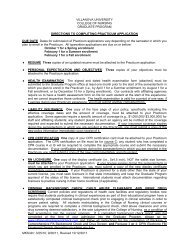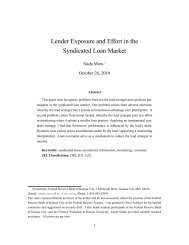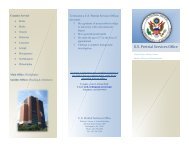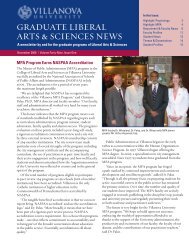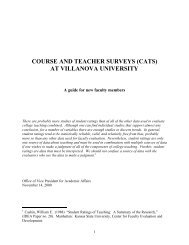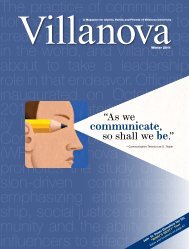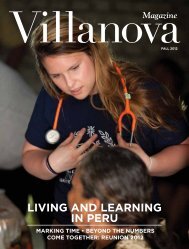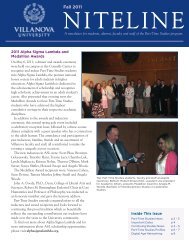Commencement 2007 - Villanova University
Commencement 2007 - Villanova University
Commencement 2007 - Villanova University
- No tags were found...
Create successful ePaper yourself
Turn your PDF publications into a flip-book with our unique Google optimized e-Paper software.
eligious studies and chaplain and counselorto the <strong>Villanova</strong> School of Law.McCormick then introduced FatherDenny as the elected speaker. As he madehis way to the podium, glasses of champagnewere distributed, prompting theAugustinian to begin with a joke.“There have been times when I lecturedto students whom I suspected weredrinking, but this is just plain obvious,”Father Denny said. “That’s okay; I’vealready tipped my glass twice.”Father Denny thanked the seniors forelecting him to speak, stating that it wasone of the greatest honors in his 25 yearsof teaching. He then shared some words ofwisdom, drawing one of them—Caritas—from <strong>Villanova</strong>’s motto: Veritas, Unitas,Caritas (Truth, Unity, Love). Everyoneneeds to love his or her family, friends,neighbors, strangers and ourselves, he said,explaining that while we cannot like everyone,love is necessary.“Jesus’ mandate is not to like, but tolove. At <strong>Villanova</strong>, we are rooted inFaculty members who were finalists in the seniors’ vote for who will give the “Last Lecture”join the winner, the Rev. John T. Denny, O.S.A. (fourth from left), in toasting the Class of <strong>2007</strong>.His colleagues are (from left) Dr. Theresa Capriotti ’95 M.S.N., Dr. James O’Brien, Dr. Noah P.Barsky, Dr. Bernard J. Gallagher and Dr. Brian Jones.Caritas, rooted in love,” Father Dennyreminded the seniors, alluded to the<strong>Villanova</strong> seal. It depicts as one of itselements the flaming heart, symbolizingSt. Augustine of Hippo’s search to knowGod and his love of neighbor.“So, when you leave <strong>Villanova</strong>, be sureto leave with this Caritas in your heart,”Father Denny concluded. His “Last Lecture”was followed by fervent applause.McCormick then led the toast to thesenior class as the “Alma Mater” played.JOHN WELSH (BOTH)Feminism in Iran: Not a New PhenomenonBY ANTHONY MAALOUF ’08 G.S.Dr. Afsaneh Najmabadi, a Harvard<strong>University</strong> professor of history andwomen’s studies, gave a public lectureat <strong>Villanova</strong> <strong>University</strong> on “Feminism,Secularism, and the Challenges of Women’sRights Activism in an Islamic Republic.”She was the keynote speaker on March29 for the 18th annual Elizabeth CadyStanton Student Research Conference.Held in the <strong>Villanova</strong> Room of theConnelly Center, her lecture was sponsoredby the Women’s Studies Programand the Center for Arab and IslamicStudies, as well as the Greater PhiladelphiaWomen’s Studies Consortium. Dr.Najmabadi was the consortium’s visitingscholar March 25-29.Her book, Women with Mustaches andMen without Beards: Gender and SexualAnxieties of Iranian Modernity (2005),examines Iran’s 19th-century culturaltransformations. She earned degrees inphysics from Radcliffe College and Harvardand a Ph.D. in sociology from the<strong>University</strong> of Manchester. She has beena Fellow at Princeton’s Institute forAdvanced Study and Brown <strong>University</strong>’sPembroke Center for Teaching andResearch on Women.In Iran, public dialogue on the role ofwomen in an Islamic society is the norm,Najmabadi stated. “But this is nothingnew,” she insisted. “There are successes ofearly feminists that trace back to the 1930s,during the reign of Reza Pahlavi,” the shahfrom 1925-1941. During his rule, Iranestablished schools for girls and changed itsmarriage laws to be fairer to women.“It was a period of the women’s awakening,”Najmabadi said. Many otherreforms also were significant for women,including the order to remove the veils in1936, she said.Pahlavi’s policies were not simply aroyal gift to women but a result of two anda half decades of aggressive work on behalfof women’s rights, noted the feminist historian.However, the shah met oppositionin the late 1930s, when Islamic clericsbegan to resist his policies.“It was at this time that Islamic feministsbroke into two groups,” Najmabadiexplained. Some sided with the clerics andothers pursued a more secularist approach.JIM MCWILLIAMSIran in the 1930sinstituted reforms thatbenefited women,noted Dr. AfsanehNajmabadi. A feministhistorian at Harvard<strong>University</strong>, she hasdone groundbreakingresearch on thecultural transformationsof her native country.The divisionimpeded Iran’sfeminist movementand led tothe many obstaclesthat feministsin the next generationwouldhave to face. Feministson the secularside in Islamiccountries wereoften accused ofconspiring withWesterners.The future,according toNajmabadi, mightbe a brighter onefor feminism.“There is a re-emergenceof conversations between secularistfeminists and Islamic feminists,” the Harvardscholar said. “It is new and fragile, but key tomoving toward an overall acceptance of‘Islamic feminism,’ ” she suggested.Najmabadi’s speech was followed by abanquet during which undergraduate andgraduate students presented their papersrelating to the topic of women’s studies,written for a variety of classes. Also honoredwere seniors who had minors or concentrationsin Women’s Studies (see page 58).Summer <strong>2007</strong> 45



